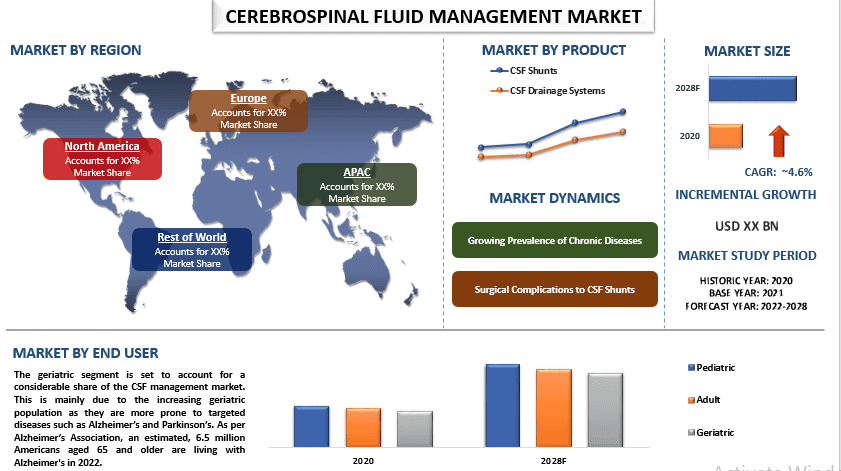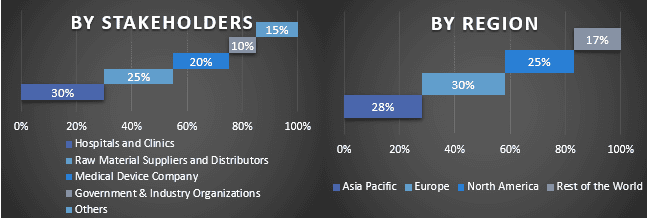- Inicio
- Acerca de nosotros
- Industria
- Servicios
- Leyendo
- Contáctenos
Mercado de gestión del líquido cefalorraquídeo: Análisis actual y pronóstico (2022-2028)
Énfasis en el producto (derivaciones LCR, sistemas de drenaje LCR); Usuario final (pediátrico, adulto, geriátrico); y Región/País

Se espera que el mercado mundial de gestión del líquido cefalorraquídeo crezca a una tasa significativa de alrededor del 4,6% durante el período de previsión. El líquido cefalorraquídeo está formado por el tejido que recubre los ventrículos (cavidades) del cerebro. Fluye dentro y alrededor del cerebro y la médula espinal para proteger contra daños y proporcionar nutrición. La creciente prevalencia de enfermedades neurológicas en todo el mundo aumenta la incidencia de trastornos del líquido cefalorraquídeo, como la hidrocefalia y la ventriculomegalia. Según el NCBI, en 2022, la prevalencia global general de hidrocefalia es de aproximadamente 85 por cada 100.000 personas, con una diferencia significativa entre los diferentes grupos de edad: 88 por cada 100.000 para la población pediátrica y 11 por cada 100.000 en adultos. Se prevé que la creciente carga de trastornos neurológicos en todo el mundo impulse el crecimiento del mercado de gestión del líquido cefalorraquídeo. Además, el aumento de la I+D en los avances de las tecnologías de dispositivos, junto con los lanzamientos de productos, está impulsando el crecimiento del mercado.
Elekta, Medtronic, B. Braun SE, Sophysa, BeckerSmith Medical, Neuromedex GmbH, Medical Device Business Services, Inc., Spiegelberg GmbH & Co. KG, Integra LifeSciences, Möller Medical GmbH son algunos de los actores clave en el mercado. Estos actores han emprendido varias fusiones y adquisiciones junto con asociaciones para facilitar a los clientes productos/tecnologías innovadores y de alta tecnología.
Perspectivas presentadas en el informe
"Entre los productos, la categoría de derivaciones de LCR mantendrá una cuota de mercado significativa durante el período de previsión"
Según el tipo, el mercado se segmenta en derivaciones de LCR y sistemas de drenaje de LCR. El segmento de derivaciones de LCR mantuvo una cuota de mercado significativa en 2020. El aumento de los casos de trastornos del líquido cefalorraquídeo, como la hidrocefalia y la hipertrofia ventricular, el aumento de la cirugía de derivación, la integración de sensores avanzados en las derivaciones de LCR y la creciente necesidad de cirugía mínimamente invasiva impulsan el segmento. La hidrocefalia se produce en dos de cada 1.000 nacimientos en los Estados Unidos. No se sabe cuántas personas la desarrollan después del nacimiento. Aproximadamente 125.000 personas viven con derivaciones de líquido cefalorraquídeo (LCR) y se colocan 33.000 derivaciones anualmente en los Estados Unidos, según UCLA Health en 2021.
"Entre los usuarios finales, los geriátricos tendrán una cuota significativa en el mercado en 2020"
Sobre la base del usuario final, el mercado se clasifica en pediátrico, adulto y geriátrico. Entre ellos, el segmento geriátrico está llamado a representar una cuota considerable del mercado de gestión del LCR. Esto se debe principalmente al aumento de la población geriátrica, ya que son más propensos a enfermedades específicas como el Alzheimer y el Parkinson. Según la Asociación de Alzheimer, se estima que 6,5 millones de estadounidenses de 65 años o más viven con Alzheimer en 2022.
"Se espera que Norteamérica domine el mercado"
En 2020, se espera que Norteamérica crezca a una tasa de crecimiento significativa debido a la infraestructura médica bien establecida, la creciente concienciación sobre las opciones de tratamiento de la hidrocefalia disponibles y la presencia de los principales actores del mercado en la región. Además, Norteamérica domina el mercado debido a la alta prevalencia de trastornos nerviosos en la población geriátrica de la región. La enfermedad de Alzheimer es la causa más común de demencia en las personas mayores. Según NCBI, En 2021, alrededor de 6,2 millones de adultos estadounidenses de 65 años o más vivían con demencia. Además, un aumento en la concienciación sobre los problemas de salud y los servicios personalizados en las clínicas está apoyando el crecimiento del mercado.
Razones para comprar este informe:
- El estudio incluye el dimensionamiento del mercado y el análisis de las previsiones validados por expertos clave autentificados de la industria.
- El informe presenta una rápida revisión del rendimiento general de la industria de un vistazo.
- El informe cubre un análisis en profundidad de los principales pares de la industria con un enfoque principal en las finanzas clave del negocio, la cartera de productos, las estrategias de expansión y los desarrollos recientes.
- Examen detallado de los impulsores, las restricciones, las tendencias clave y las oportunidades que prevalecen en la industria.
- El estudio cubre exhaustivamente el mercado a través de diferentes segmentos.
- Análisis profundo a nivel regional de la industria.
Opciones de personalización:
El mercado mundial de gestión del líquido cefalorraquídeo puede personalizarse aún más según los requisitos o cualquier otro segmento de mercado. Además, UMI entiende que puede tener sus propias necesidades empresariales, por lo que no dude en ponerse en contacto con nosotros para obtener un informe que se adapte completamente a sus necesidades.
Tabla de contenido
Metodología de Investigación para el Análisis del Mercado de la Gestión del Líquido Cefalorraquídeo (2022-2028)
El análisis del mercado histórico, la estimación del mercado actual y la previsión del mercado futuro del mercado mundial de la gestión del líquido cefalorraquídeo fueron los tres pasos principales emprendidos para crear y analizar la adopción de la gestión del líquido cefalorraquídeo en las principales regiones a nivel mundial. Se llevó a cabo una investigación secundaria exhaustiva para recopilar las cifras históricas del mercado y estimar el tamaño actual del mercado. En segundo lugar, para validar estas perspectivas, se tomaron en consideración numerosos hallazgos y supuestos. Además, también se realizaron entrevistas primarias exhaustivas con expertos de la industria en toda la cadena de valor del mercado mundial de la gestión del líquido cefalorraquídeo. Tras la asunción y validación de las cifras del mercado a través de entrevistas primarias, empleamos un enfoque de arriba hacia abajo/de abajo hacia arriba para pronosticar el tamaño completo del mercado. Posteriormente, se adoptaron métodos de desglose del mercado y triangulación de datos para estimar y analizar el tamaño del mercado de los segmentos y subsegmentos de la industria en cuestión. La metodología detallada se explica a continuación:
Análisis del Tamaño Histórico del Mercado
Paso 1: Estudio Profundo de Fuentes Secundarias:
Se llevó a cabo un estudio secundario detallado para obtener el tamaño histórico del mercado de la gestión del líquido cefalorraquídeo a través de fuentes internas de la empresa, tales como informes anuales y estados financieros, presentaciones de resultados, comunicados de prensa, etc., y fuentes externas, incluyendo revistas, noticias y artículos, publicaciones gubernamentales, publicaciones de la competencia, informes del sector, bases de datos de terceros y otras publicaciones creíbles.
Paso 2: Segmentación del Mercado:
Después de obtener el tamaño histórico del mercado de la gestión del líquido cefalorraquídeo, realizamos un análisis secundario detallado para recopilar información histórica del mercado y compartirla para diferentes segmentos y subsegmentos para las principales regiones. Los principales segmentos incluidos en el informe son el producto y el usuario final. Además, se realizaron análisis a nivel de país para evaluar la adopción general de modelos de prueba en esa región.
Paso 3: Análisis de Factores:
Después de adquirir el tamaño histórico del mercado de diferentes segmentos y subsegmentos, llevamos a cabo un análisis de factores detallado para estimar el tamaño actual del mercado de la gestión del líquido cefalorraquídeo. Además, realizamos un análisis de factores utilizando variables dependientes e independientes, tales como varios productos y el usuario final de la gestión del líquido cefalorraquídeo. Se llevó a cabo un análisis exhaustivo de los escenarios de oferta y demanda, teniendo en cuenta las principales asociaciones, fusiones y adquisiciones, la expansión empresarial y los lanzamientos de productos en el sector del mercado de la gestión del líquido cefalorraquídeo en todo el mundo.
Estimación y Previsión del Tamaño Actual del Mercado
Tamaño Actual del Mercado: Basándonos en la información práctica de los 3 pasos anteriores, llegamos al tamaño actual del mercado, a los actores clave en el mercado mundial de la gestión del líquido cefalorraquídeo y a las cuotas de mercado de los segmentos. Todos los porcentajes de cuota requeridos y los desgloses del mercado se determinaron utilizando el enfoque secundario mencionado anteriormente y se verificaron a través de entrevistas primarias.
Estimación y Previsión: Para la estimación y previsión del mercado, se asignaron ponderaciones a diferentes factores, incluyendo los impulsores y las tendencias, las restricciones y las oportunidades disponibles para las partes interesadas. Después de analizar estos factores, se aplicaron técnicas de previsión relevantes, es decir, el enfoque de arriba hacia abajo/de abajo hacia arriba, para llegar a la previsión del mercado para 2028 para diferentes segmentos y subsegmentos en los principales mercados a nivel mundial. La metodología de investigación adoptada para estimar el tamaño del mercado abarca:
- El tamaño del mercado de la industria, en términos de ingresos (USD) y la tasa de adopción del mercado de la gestión del líquido cefalorraquídeo en los principales mercados a nivel nacional
- Todos los porcentajes de participación, divisiones y desgloses de los segmentos y subsegmentos del mercado
- Actores clave en el mercado mundial de la gestión del líquido cefalorraquídeo en términos de productos ofrecidos. Además, las estrategias de crecimiento adoptadas por estos actores para competir en el mercado de rápido crecimiento
Validación del Tamaño y la Cuota del Mercado
Investigación Primaria: Se realizaron entrevistas en profundidad con los Líderes de Opinión Clave (Key Opinion Leaders, KOL) incluyendo los Ejecutivos de Alto Nivel (CXO/VP, Jefe de Ventas, Jefe de Marketing, Jefe de Operaciones, Jefe Regional, Jefe de País, etc.) en las principales regiones. Los resultados de la investigación primaria se resumieron y se realizó un análisis estadístico para probar la hipótesis planteada. Los datos de la investigación primaria se consolidaron con los resultados secundarios, convirtiendo así la información en información práctica.
División de los Participantes Primarios en Diferentes Regiones

Ingeniería del Mercado
Se empleó la técnica de triangulación de datos para completar la estimación general del mercado y para llegar a cifras estadísticas precisas para cada segmento y subsegmento del mercado mundial de la gestión del líquido cefalorraquídeo. Los datos se dividieron en varios segmentos y subsegmentos después de estudiar varios parámetros y tendencias en las áreas de producto y usuario final en el mercado mundial de la gestión del líquido cefalorraquídeo.
El objetivo principal del Estudio del Mercado Global de la Gestión del Líquido Cefalorraquídeo
Las tendencias actuales y futuras del mercado mundial de la gestión del líquido cefalorraquídeo se señalaron en el estudio. Los inversores pueden obtener información estratégica para basar su discreción en las inversiones en el análisis cualitativo y cuantitativo realizado en el estudio. Las tendencias actuales y futuras del mercado determinaron el atractivo general del mercado a nivel regional, proporcionando una plataforma para que el participante industrial explote el mercado sin explotar para beneficiarse de una ventaja de ser el primero en actuar. Otros objetivos cuantitativos de los estudios incluyen:
- Analizar el tamaño actual y previsto del mercado de la gestión del líquido cefalorraquídeo en términos de valor (USD). Además, analizar el tamaño actual y previsto del mercado de diferentes segmentos y subsegmentos
- Los segmentos del estudio incluyen áreas de producto y usuario final.
- Definir y analizar el marco regulatorio para la gestión del líquido cefalorraquídeo
- Analizar la cadena de valor involucrada con la presencia de varios intermediarios, junto con el análisis de los comportamientos de los clientes y de la competencia de la industria.
- Analizar el tamaño actual y previsto del mercado de la gestión del líquido cefalorraquídeo para la principal región.
- Los principales países de las regiones estudiadas en el informe incluyen Asia Pacífico, Europa, Norteamérica y el resto del mundo.
- Perfiles de las empresas del mercado de la gestión del líquido cefalorraquídeo y las estrategias de crecimiento adoptadas por los actores del mercado para mantenerse en el mercado de rápido crecimiento
- Análisis regional profundo de la industria
Relacionados Informes
Los clientes que compraron este artículo también compraron










